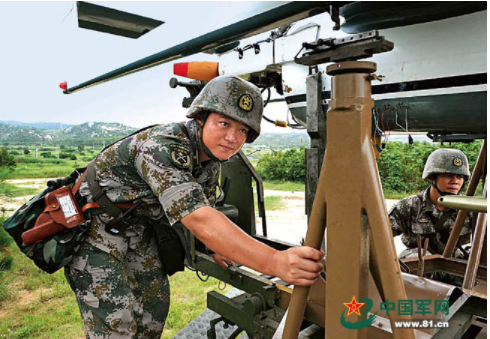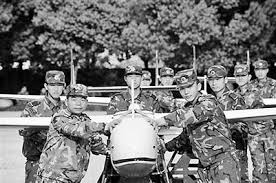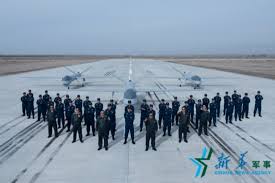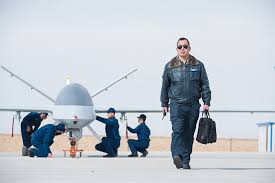By Elsa B. Kania
This essay is part of the #WarBots series, which asked a group of academics and national security professionals to provide their thoughts on the confluence of automation and unmanned technologies and their impact in the conduct of war. We hope this launches a debate that may one day shape policy. Even as the character of conflict is transformed by the advent of robotics and artificial intelligence (AI) on the battlefield, the human factor is no less important in this machine age of warfare. However, the typical terminological characterization of military drones as unmanned aerial vehicles (UAVs) reflects a tendency to neglect those responsible for the operation of these uninhabited systems.[1] Ironically, the use of highly automated weapons and most larger UAVs, such as the Predator, often require the involvement of more humans than the typical manned aircraft.
Even while adopting the parlance Remotely Piloted Aircraft (RPA), the U.S. military initially struggled with the underlying human capital challenges associated with these systems.[3] For instance, the reported resistance of pilots to taking on the role of UAV operator and an occasional tendency to discount these drone pilots have contributed to difficulties with recruitment and retention. As the U.S. military’s experience has thus demonstrated, the capacity to recruit, educate, train, and retain an adequate number of UAV pilots, operators, and relevant personnel can be a critical element of a military’s capacity to engage in high-tempo operations with unmanned systems in a conflict scenario. China’s President and Chairman of the Central Military Commission Xi Jinping himself has highlighted the importance of “cultivating good personnel” given the importance of UAVs on the modern battlefield.[4] To evaluate the Chinese People’s Liberation Army’s (PLA) approach to unmanned and autonomous systems, it is critical to consider this critical human factor.[5]
The PLA’s history with the development and employment of unmanned systems dates back decades. Initially, China had acquired its first UAV, the Lavochkin (La-17), a fairly unsophisticated radio-controlled target drone, from the Soviet Union by the 1950s.[6] After the Sino-Soviet split and resulting withdrawal of USSR military support, the PLA Air Force decided to develop its own unmanned systems in the late 1950s and early 1960s.[7,8] This motivated the production of the PLA’s first notionally indigenous UAV, the Chang Kong-1 (“Vast Sky,”长空一号, CK-1) UAV, a radio-controlled target drone based on a reverse engineering of the La-17, which was first successfully tested in December 1966.[9] In the 1960s, the PLA also recovered U.S. AQM-34 Firebee drones that were shot down in North Vietnam and reverse engineered the Wu Zhen-5 (无侦-5, WZ-5).[10[ By the 1980s, China developed the Cai Hong-1
(“Rainbow,” 彩虹一号, CH-1), a high-altitude, long-endurance (HALE) UAV.[11] During these years, the PLA Air Force’s early testing and development of UAVs took place at a remote base in the Gobi Desert, and the PLA Air Force engineers involved in this process included Zhao Xu (赵煦), hailed as China’s father of UAVs.[12] In more recent years, China’s success in the indigenous development of UAVs—and emergence as a major exporter—has been celebrated as a major accomplishment. Chinese UAVs, such as the CH-3, 4, and 5 and the Wing Loong I and II, which are roughly analogous to the Predator and Reaper respectively, have proliferated widely, including throughout the Middle East and in Central and Southeast Asia.[13]
Zhao Xu and His Scientific Team
As China progressed in the development and fielding of UAVs, the PLA started to establish educational and training programs for UAV operators across the services, reflecting recognition of the importance of personnel. In 1994, the PLA created its first course for cadets at the Army Artillery Academy to train as UAV operators and technicians, who could go on to leverage UAVs for battlefield reconnaissance, target positioning, and damage assessment.[14] There have been nearly a dozen PLA academic institutions, such as the PLA Air Force Engineering University, that provide education and training for future UAV officers and enlisted specialists.[15] For example, the PLA’s Naval Aviation Engineering Academy has instructed the technical officer cadre for assault UAVs.[16] It is difficult to determine the level of sophistication of the instruction that students in these programs receive. There are references to students at the Ordnance Engineering College engaging in training with UAVs that included launch, remote control, and real-time image acquisition.[17] Beyond formal educational programs, there are also specialized courses available to officers and enlisted personnel, and certain units have organized training exercises focused on advancing operational capabilities, often training to engage in battlefield reconnaissance and electronic countermeasures.[18]
While creating these educational and training programs for UAV operators, the PLA has also progressed towards formalizing and standardizing training with UAVs. In 2001, the PLA drafted its first “UAV Outline of Military Training and Evaluation” (UAV OMTE, 无人机训练与考核大纲).[19] Although there are no details available about the contents of this OMTE, PLA OMTE generally offer guidance for training, including goals, principles, and content, as well as implementation phases and procedures, and often require several years to draft and revise.[20,21] The development of a formal curriculum for UAV operational units at that surprisingly early stage appears to be indication that the PLA as a whole was already starting to focus on advancing its UAV capabilities through more systematic training at that time. Since PLA updated most of its OMTE in 2009, this UAV OMTE may have been revised at that time or remain pending revision.

Li Chanyong, the "UAV King"
Despite the efforts to advance education and training, certain shortcomings have remained and could persist, despite at least ad hoc efforts to mitigate them. According to Major Li Changyong (李长勇), the commander of a PLA Army UAV battalion, “that the UAV specialization has gaps isn’t frightful, perhaps it’s that everyone is waiting for someone else to come fill in the gaps.”[22] As of the mid-2000s, due to the lack of sufficiently standardized operations regulations, instruction regarding UAVs was often “reliant on a single person’s experience.”[23] As such, when he took on the post of UAV battalion commander in 2012, Li Changyong, characterized in PLA media as the “UAV king” (无人机王), took the initiative to compile lengthy regulations regarding the operation of the UAV model with which his unit was equipped, based on extensive engagement with local UAV manufacturers and technicians.[24,25] As of 2016, Li’s UAV battalion had also introduced its own simulation training room within which UAV operators could practice.[26] It is unclear how extensively such new regulations and successful practices for training have been implemented across the PLA to date.[27] There also appears to have been active experimentation at the unit level with new tactical approaches for the use of UAVs.[28,29] However, in some cases, the frequency of PLA training with UAVs may be restricted by considerations of airspace and aviation management, perhaps in competition with manned aircraft.[30]
Ju Xiaochengm the UAV "Golden Launcher"
 The PLA’s apparent attention to personnel and training for unmanned operations is vividly reflected in the high-profile recognition of UAV operators and their importance. When Xi Jinping met the PLA’s delegation to the National People’s Congress in March 2016, one of the military personnel whom received particular notice was Master Sergeant Class One (一级军士长) Ju Xiaocheng (巨孝成), the director of an unmanned aerial vehicle (UAV) launch site subordinate to the Army Artillery Academy. Based on his record of 100% accuracy in UAV launches, he has been praised as the PLA’s “golden launcher” (“金牌发射手”) of military-use UAVs.[31] Among the PLA’s first UAV specialty non-commissioned officers (无人机专业士官), Ju Xiaocheng was responsible for operating and maintaining UAVs, while training an estimated 80% of the entire PLA’s UAV specialty cadre (无人机专业干部), which includes UAV operators (操作手) and technicians (技师).[32,33] At the time, Xi Jinping declared to Ju Xiaocheng, “UAVs are important combat forces for the modern battlefield. You must carry out your duties well and cultivate good personnel.”[34] Indeed, the UAV specialty has been characterized as an urgently needed discipline for the PLA, in which enrollment is targeted to continue to increase.[35] Since the PLA is building up its cadre of UAV operators in peacetime, without the pressures associated with meeting the demands of ongoing combat operations, it has perhaps thus far avoided certain challenges of recruitment and retention that the U.S. military has faced.
The PLA’s apparent attention to personnel and training for unmanned operations is vividly reflected in the high-profile recognition of UAV operators and their importance. When Xi Jinping met the PLA’s delegation to the National People’s Congress in March 2016, one of the military personnel whom received particular notice was Master Sergeant Class One (一级军士长) Ju Xiaocheng (巨孝成), the director of an unmanned aerial vehicle (UAV) launch site subordinate to the Army Artillery Academy. Based on his record of 100% accuracy in UAV launches, he has been praised as the PLA’s “golden launcher” (“金牌发射手”) of military-use UAVs.[31] Among the PLA’s first UAV specialty non-commissioned officers (无人机专业士官), Ju Xiaocheng was responsible for operating and maintaining UAVs, while training an estimated 80% of the entire PLA’s UAV specialty cadre (无人机专业干部), which includes UAV operators (操作手) and technicians (技师).[32,33] At the time, Xi Jinping declared to Ju Xiaocheng, “UAVs are important combat forces for the modern battlefield. You must carry out your duties well and cultivate good personnel.”[34] Indeed, the UAV specialty has been characterized as an urgently needed discipline for the PLA, in which enrollment is targeted to continue to increase.[35] Since the PLA is building up its cadre of UAV operators in peacetime, without the pressures associated with meeting the demands of ongoing combat operations, it has perhaps thus far avoided certain challenges of recruitment and retention that the U.S. military has faced.
The PLA’s approach to employment of unmanned systems and requirements for their operators differ across services. The PLA Army primarily operates smaller, tactical UAVs such as the ASN-206 and ASN-207, used for battlefield reconnaissance and electronic warfare. The PLA Rocket Force similarly appears to use UAVs primarily for such roles as battle damage assessment and perhaps guidance for long-range missiles. The PLA Navy and Air Force, on the other hand, also operate larger and more sophisticated UAVs, the medium-altitude long-endurance (MALE) BZK-005, used for reconnaissance, and the GJ-1 (Gongji-1, 攻击-1,) variant of the Pterodactyl (Yilong, 翼龙 or Wing Loong), a MALE UAV used for integrated reconnaissance and strike. The PLA has been testing and may soon field the GJ-2, a more advanced version of the Pterodactyl.[36,37] The ongoing and future introduction of new types of UAVs, ranging from the ASN-301, a reversed-engineered version of Israel’s Harpy, an anti-radiation drone, to the Xianglong (“Soar Dragon,” 翔龙), a high-altitude long-endurance (HALE) UAV for potential missions of long-range reconnaissance and electronic warfare, could also create new challenges for operators.[38-41]
Li Hao, His Colleagues, and the GJ-1
 In particular, within the PLA Air Force, a number of UAV pilots have transitioned from careers as pilots of manned aircraft to UAVs as this service has actively built up its unmanned combat forces. For instance, Li Hao (李浩), a UAV pilot prominently profiled in PLA media, decided to take on that role in 2010 once he could no longer continue as a traditional pilot.[42] In his career as a UAV pilot, Li Hao has taken on a key role in the construction the PLA Air Force’s UAV capabilities, actively contributing to breakthroughs in technical and operational challenges to increase combat effectiveness. As portrayed in media accounts, Li Hao has expressed great enthusiasm for “the golden combination of new-type unmanned warfare forces and new manned aircraft technology and tactics,” reflecting the PLA’s focus on techniques parallel to the U.S. military’s manned-unmanned teaming.[43] He has taken the lead in the initial incorporation of UAVs into Air Force operations, first in the 2012 Red Sword (红剑) exercise, in which UAVs were used for reconnaissance and imagery, and then again piloted the GJ-1 in its first engagement in a live-fire strike in a joint, PLA-wide exercise in 2014 and then its participation in Peace Mission 2014, a counterterrorism exercise with the Shanghai Cooperation Organization.[44] Li Hao also played an integral role in helping the PLA adjust to the personnel challenges associated with the operation of more complex UAVs, seeking to mitigate the lack of standardized training materials and accelerate the cultivation of talent, including through writing “UAV Training Requirements” (无人机训练条令).[45] For the PLA Air Force, key and continuing challenges include operating under complex electromagnetic environments and enhancing coordination between manned and unmanned systems.
In particular, within the PLA Air Force, a number of UAV pilots have transitioned from careers as pilots of manned aircraft to UAVs as this service has actively built up its unmanned combat forces. For instance, Li Hao (李浩), a UAV pilot prominently profiled in PLA media, decided to take on that role in 2010 once he could no longer continue as a traditional pilot.[42] In his career as a UAV pilot, Li Hao has taken on a key role in the construction the PLA Air Force’s UAV capabilities, actively contributing to breakthroughs in technical and operational challenges to increase combat effectiveness. As portrayed in media accounts, Li Hao has expressed great enthusiasm for “the golden combination of new-type unmanned warfare forces and new manned aircraft technology and tactics,” reflecting the PLA’s focus on techniques parallel to the U.S. military’s manned-unmanned teaming.[43] He has taken the lead in the initial incorporation of UAVs into Air Force operations, first in the 2012 Red Sword (红剑) exercise, in which UAVs were used for reconnaissance and imagery, and then again piloted the GJ-1 in its first engagement in a live-fire strike in a joint, PLA-wide exercise in 2014 and then its participation in Peace Mission 2014, a counterterrorism exercise with the Shanghai Cooperation Organization.[44] Li Hao also played an integral role in helping the PLA adjust to the personnel challenges associated with the operation of more complex UAVs, seeking to mitigate the lack of standardized training materials and accelerate the cultivation of talent, including through writing “UAV Training Requirements” (无人机训练条令).[45] For the PLA Air Force, key and continuing challenges include operating under complex electromagnetic environments and enhancing coordination between manned and unmanned systems.
Li Hao
 Looking beyond the increasing sophistication of China’s unmanned systems, the PLA’s actual operational UAV capability will depend upon these human and organizational dimensions of its approach to these systems. It is notable that the PLA appears to have progressed substantively in its institutionalization of education and training programs, as well as a career track for UAV officer and enlisted force operators, across multiple services. There could be but are not obvious indications of cultural or organizational resistance to the PLA’s widespread adoption of UAVs, even though these uninhabited systems could, in some cases, displace conventional pilots and platforms. Frictions could be less prevalent because unmanned systems are considered among “new-type forces” (新型力量) of key strategic importance, and there have not been controversies akin to those that have arisen in the U.S. context due to the uses of unmanned systems for counterterrorism campaigns.[46]
Looking beyond the increasing sophistication of China’s unmanned systems, the PLA’s actual operational UAV capability will depend upon these human and organizational dimensions of its approach to these systems. It is notable that the PLA appears to have progressed substantively in its institutionalization of education and training programs, as well as a career track for UAV officer and enlisted force operators, across multiple services. There could be but are not obvious indications of cultural or organizational resistance to the PLA’s widespread adoption of UAVs, even though these uninhabited systems could, in some cases, displace conventional pilots and platforms. Frictions could be less prevalent because unmanned systems are considered among “new-type forces” (新型力量) of key strategic importance, and there have not been controversies akin to those that have arisen in the U.S. context due to the uses of unmanned systems for counterterrorism campaigns.[46]
Indeed, the PLA appears enthusiastic in its embrace of UAVs, seeking to capitalize upon the anticipated transformation of the character of conflict towards “unmanned, intangible, silent warfare” (“无人, 无形, 无声”战争) that is increasingly “intelligentized” (智能化) due to the advent of AI on the battlefield.[47] The PLA’s expanding employment of unmanned systems for multiple missions will likely result in the establishment of new dedicated UAV units, further increasing the demand for qualified UAV operators and technicians. Despite continued challenges, the PLA remains focused on enhancing its UAV forces’ operational capabilities, while engaging in more sophisticated joint training exercises with unmanned systems, including in major exercises like “Firepower” (Huoli, 火力) and Stride (Kuayue, 跨越).
What does the PLA’s approach so far to the humans behind their unmanned systems reveal about its potential engagement with the challenges associated with the highly automated and autonomous systems it is currently developing? Despite the myth that such systems tend to replace humans, requiring smaller numbers of combatants with lower levels of expertise, there is clear evidence to date that the human challenges of such systems are considerable, often requiring higher levels of specialized training.[48] In this regard, PLA’s active focus on the development of personnel to operate UAVs could constitute an early case that demonstrates that the PLA will likely confront considerable challenges in the process of learning to use such high-tech systems more effectively, given that human capital and training have remained major issues. However, it appears that the PLA does recognize the importance of the human element in the machine age of warfare.
Although the PLA seems to have less of an aversion than the U.S. military to taking humans out of the loop in operational circumstances in which doing so may be advantageous, there are indications that it is nonetheless focused on the value of human-machine collaboration and integration. For instance, it is telling that PLA theorists are starting to incorporate the distinction between humans in the loop and on the loop (i.e., exercising supervisory control) into their writings, and even into a patent for a system designed to allow a human operator to control multiple UAVs.[49,50] Lieutenant General Liu Guozhi, head of the Central Military Commission’s Science and Technology Commission, anticipates that human-machine hybrid (人机混合) intelligence will be the highest form of future intelligence.[51] As warfare progresses towards the machine age, the PLA and U.S. military alike will confront new challenges at this intersection of humans and new technologies.
Elsa B. Kania is an Adjunct Fellow with the Technology and National Security Program at the Center for a New American Security, where she focuses on Chinese defense innovation and emerging technologies. She is the author of “Battlefield Singularity: Artificial Intelligence, Military Revolution, and China’s Future Military Power.”

No comments:
Post a Comment